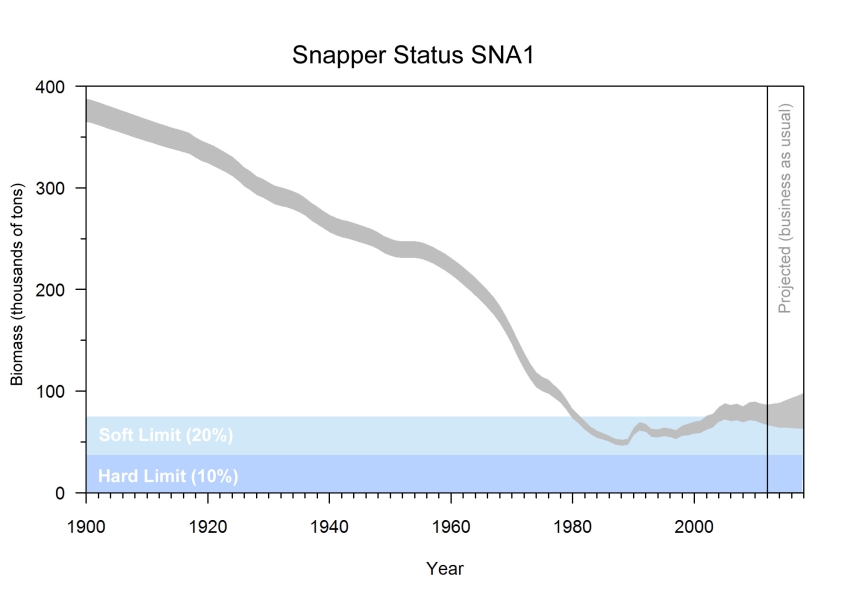A new SNA 1 stock assessment was undertaken by NIWA under contract to MPI in 2012/13. This assessment was undertaken in collaboration with the MPI Northern Inshore Science Working Group.
The graphs on the right show snapper spawning stock biomass (the estimated total weight of mature fish) in the SNA1 fishery and its component areas. This is based upon over 100 years of catch and research data, and is the output of sophisticated mathematical and statistical catch-at-age stock assessment models. This analysis was conducted in 2013, using data up to 2012. The width of the grey line shows the uncertainty in the estimate of spawning stock biomass based upon the available data.
The spawning stock biomass is the amount of mature (or spawning) fish in the population in any year. It is often expressed as a percentage of the initial (or pre-exploitation) spawning stock biomass. Note that there are also a large number of immature (non-breeding) fish in the population that are not available to the fishery, and the total biomass will be greater than the spawning stock biomass.
Fisheries managers use the spawning stock biomass compared to the initial biomass (B0), as a percentage, to express the management target. In New Zealand, this is often a number between 30% and 45% — but this depends on the species and the stock. For snapper in the SNA 1 management area, an interim target of 40% has been set by the Ministry for Primary Industries (MPI). The status of the stock compared to the management target is an important performance indicator.
In addition to a target, fisheries also assessed in terms of the risk of the stock being below some limit. In New Zealand, we have two limits:
- The soft limit – a biomass level below which a stock is deemed to be 'overfished' or depleted and needs to be actively rebuilt. This is often set at 20% B0.
- The hard limit – a biomass level below which a stock is deemed to be 'collapsed' where fishery closures should be considered in order to rebuild a stock at the fastest possible rate. This is often set at 10% B0.
These limits reflect current international best practice. When the spawning stock biomass of a population falls under 20% of its pre-exploitation amount, it can be difficult to successfully rebuild a fish stock. At biomasses below 10% this risk may become far more serious, and may even result in an ecosystem shift where species numbers are reduced to the point where other creatures may fill the niche the species used to inhabit. Actual safe levels are very hard to establish because of annual variations in the ocean environment and the influence of other species, but practical advice can be given based on a detailed analysis of each stock and its history.
For snapper in SNA1, the most recent advice given by NIWA was that the biomass in 2012 was about:
- 24% B0 in East Northland
- 19% B0 in the Hauraki Gulf and Bay of Plenty combined.
At current catch levels, and with recent levels of recruitment, the spawning stock biomass in both areas is expected to increase over the next five years, but only very slowly. However, if recruitment is at the level of the long term average, current catch levels will result in the spawning stock biomass decreasing slowly over the same period. In either case, current catches will not result in the stock rebuilding to the 40% level.
Related Content
- Information about the life cycle of snapper.
- What is a stock assessment?

